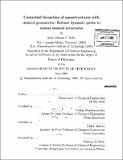Controlled formation of nanostructures with desired geometries : robust dynamic paths to robust desired structures
Author(s)
Solis, Earl Osman P. (Earl Osman Pauco)
DownloadFull printable version (34.86Mb)
Other Contributors
Massachusetts Institute of Technology. Dept. of Chemical Engineering.
Advisor
George Stephanopoulos and Paul I. Barton.
Terms of use
Metadata
Show full item recordAbstract
An essential requirement for the fabrication of future electronic, magnetic, optical and biologically-based devices, composed of constituents at the nanometer length scale, is the precise positioning of the components in the system's physical domain. We introduce the design principles, problems and methods associated with the controlled formation of nanostructures with desired geometries through a hybrid top-down and bottom-up approach: top-down formation of physical domains with externally- imposed controls and bottom-up generation of the desired structure through the self-assembly of the nanoscale constituents, driven by interparticle interactions (short- and long-range) and interactions with the external controls (e.g., electrical, magnetic, chemical). The desired nanoscale structure must be locally stable and robust to a desired level of robustness, and it should be reachable from any initial particle distribution. These two requirements frame the two elements of the design problem: (a) Static Problem: Systematic placement of externally imposed controls and determination of their intensities in order to ensure that the final desired structure is stable with a desired degree of robustness; (b) Dynamic Problem: Time-varying controls in order to ensure that the desired final structure can be reached from any initial particle distribution. The concept of external controls is realized through point conditions, which introduce attractive or repulsive interaction terms in the system potential energy. The locations of the point conditions are found through the solution of a minimum tiling problem. (cont.) Given these locations, the Static Problem is solved through the solution of combinatorially-constrained optimization problems. The Dynamic Problem is solved through a genetic algorithm search for the appropriate time-varying system degrees of freedom. Crucial to the achievement of the design goals is the necessity to break the ergodicity of the system phase space and control the subset of system states accessible to the system. More specifically, the static approach requires isolating the desired structure from all competing structures in phase space. The dynamic approach involves a multiresolution view of the system particle number, where we successively restrict the accessible volume of phase space based on coarse-grained particle number (i.e., density) specifications. We illustrate the design problems and solution methods through 1- and 2-dimensional lattice models and simulate the self-assembly process with a dynamic Monte Carlo method.
Description
Thesis (Ph. D.)--Massachusetts Institute of Technology, Dept. of Chemical Engineering, 2009. Includes bibliographical references (p. 119-121).
Date issued
2009Department
Massachusetts Institute of Technology. Department of Chemical EngineeringPublisher
Massachusetts Institute of Technology
Keywords
Chemical Engineering.